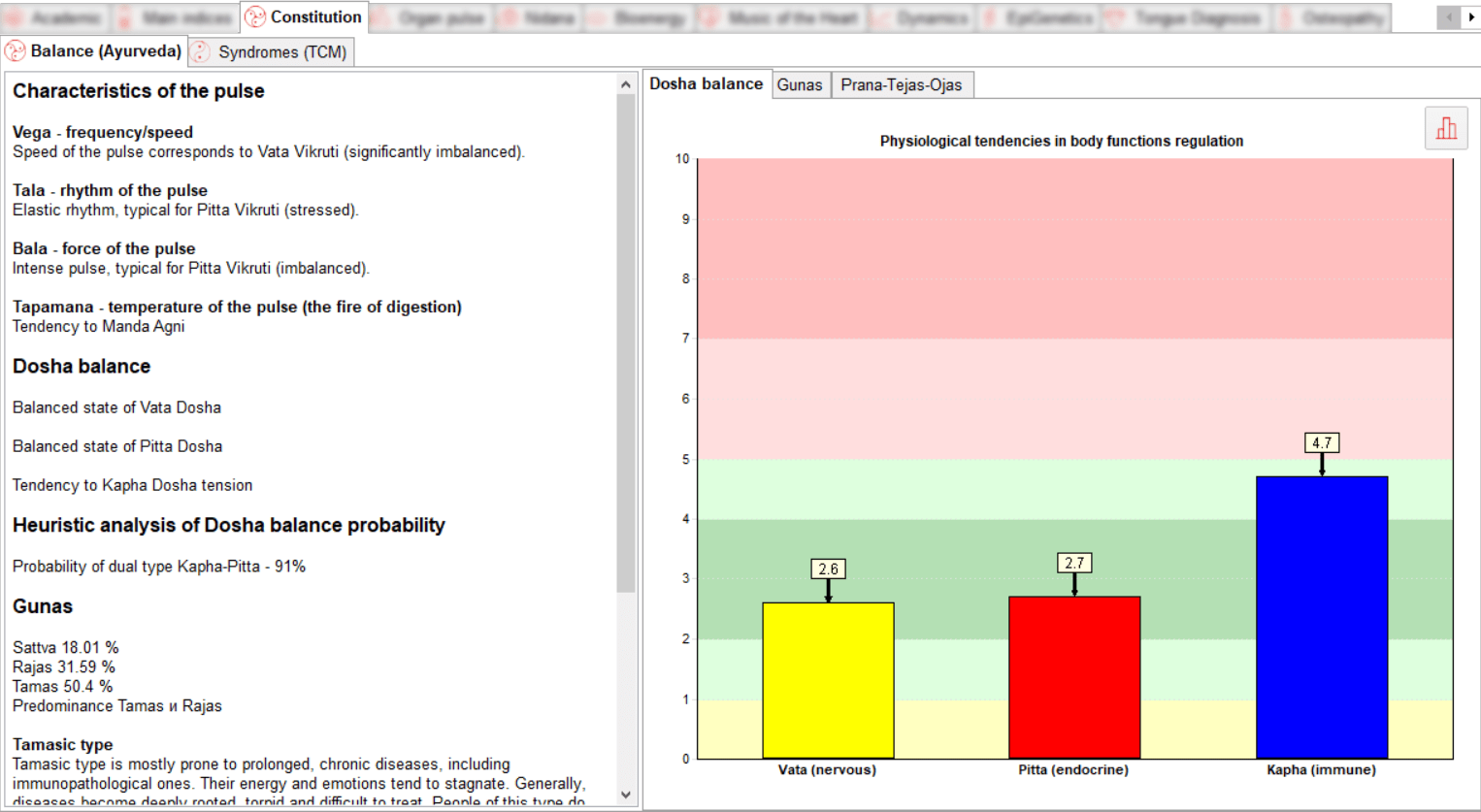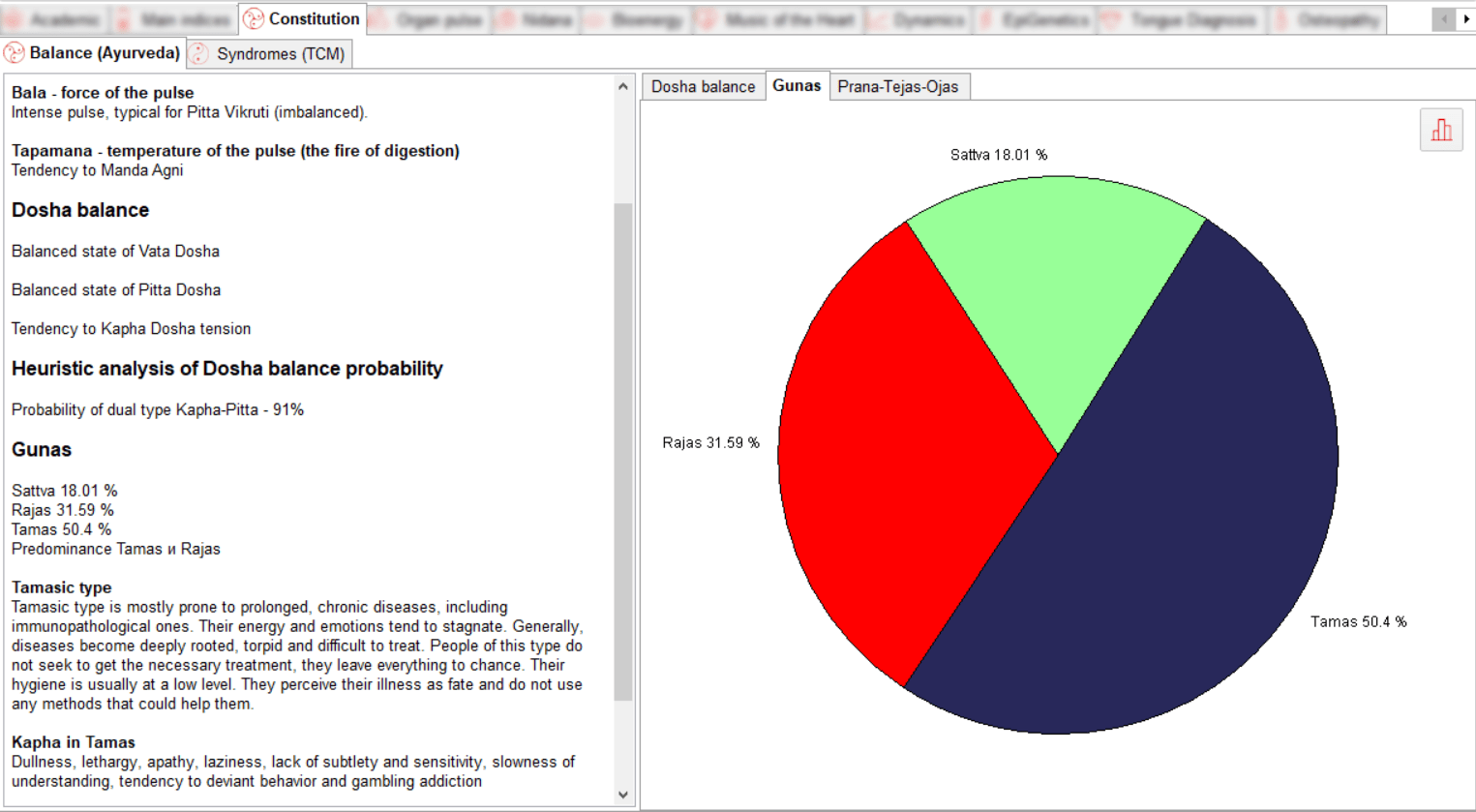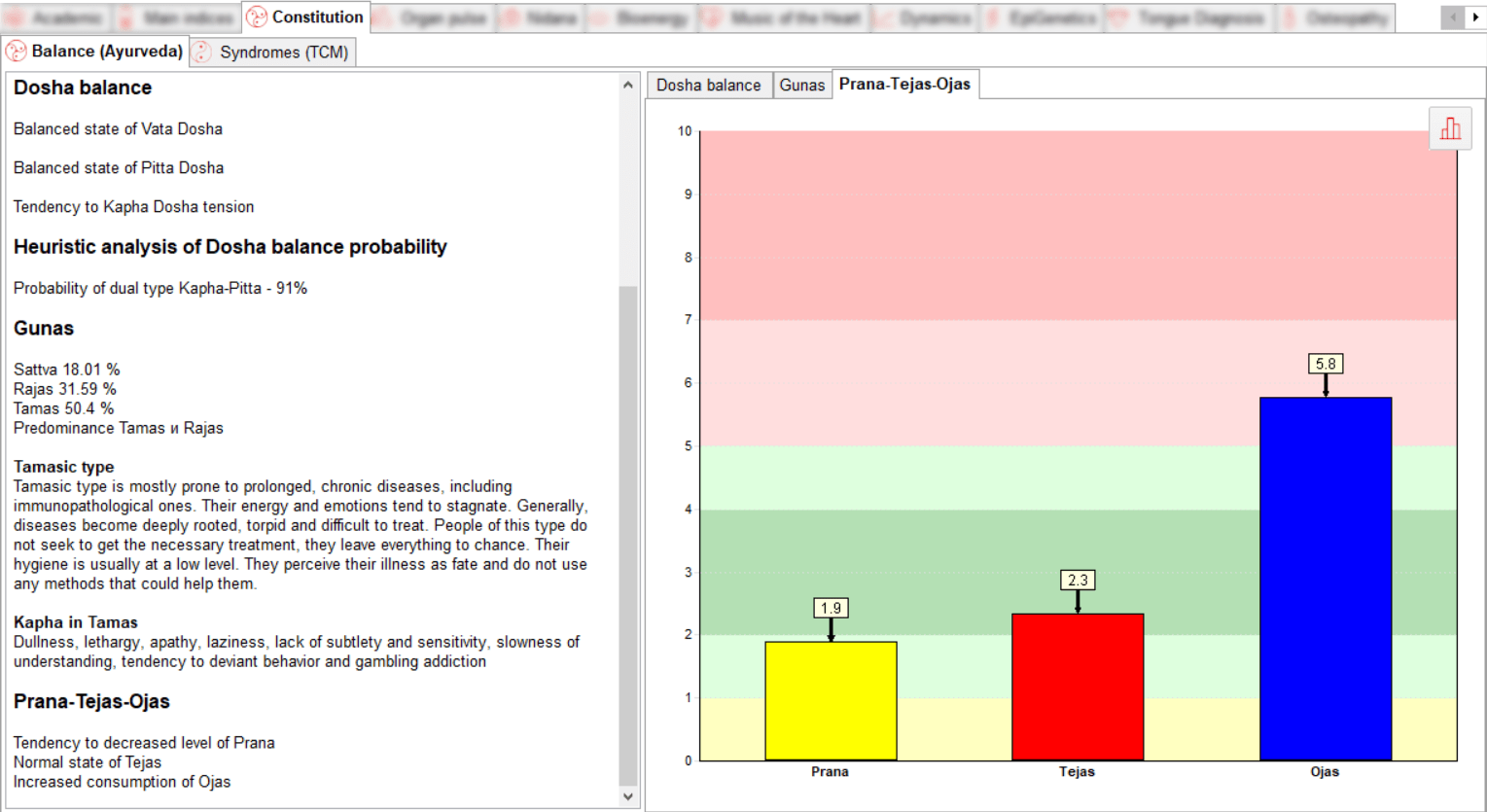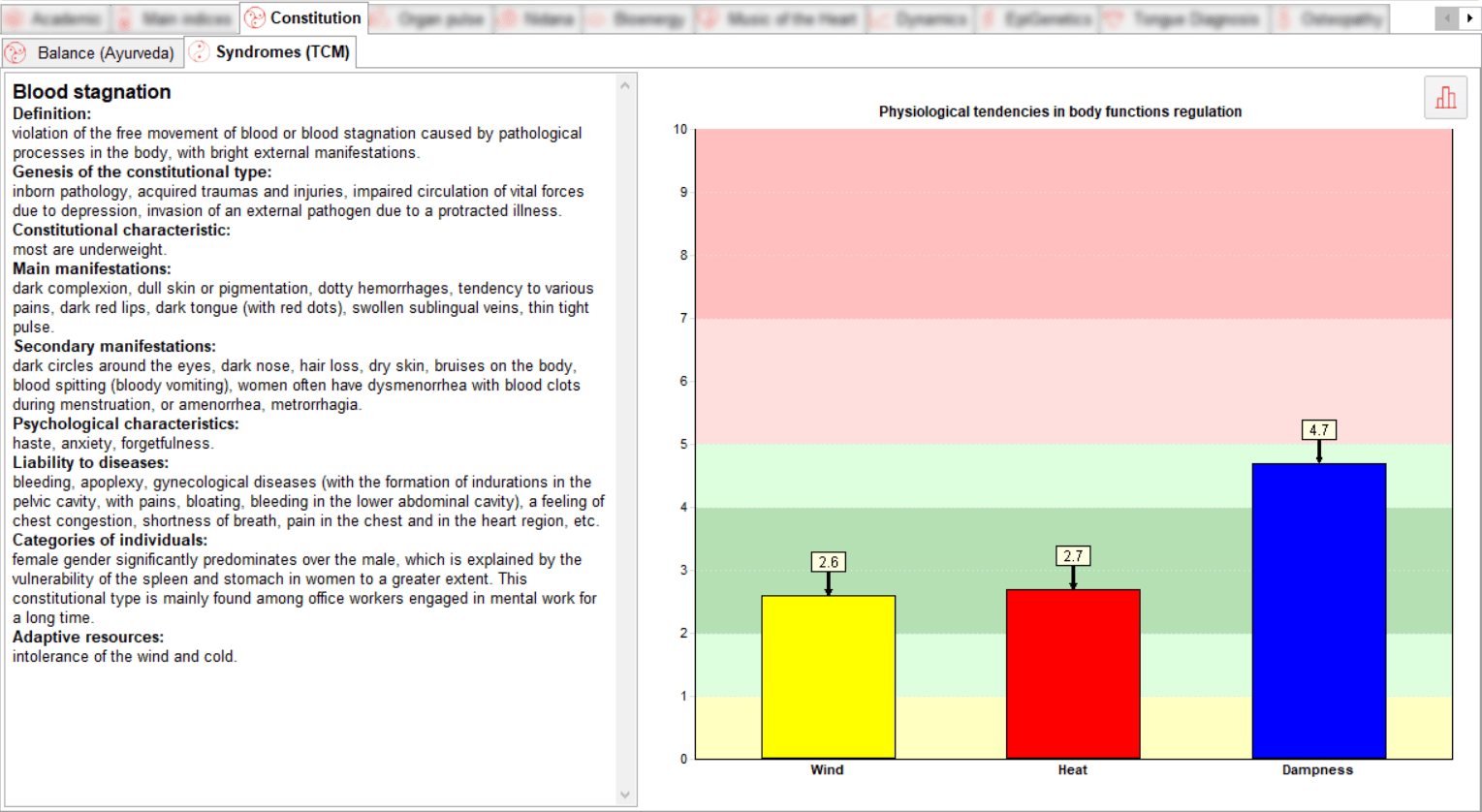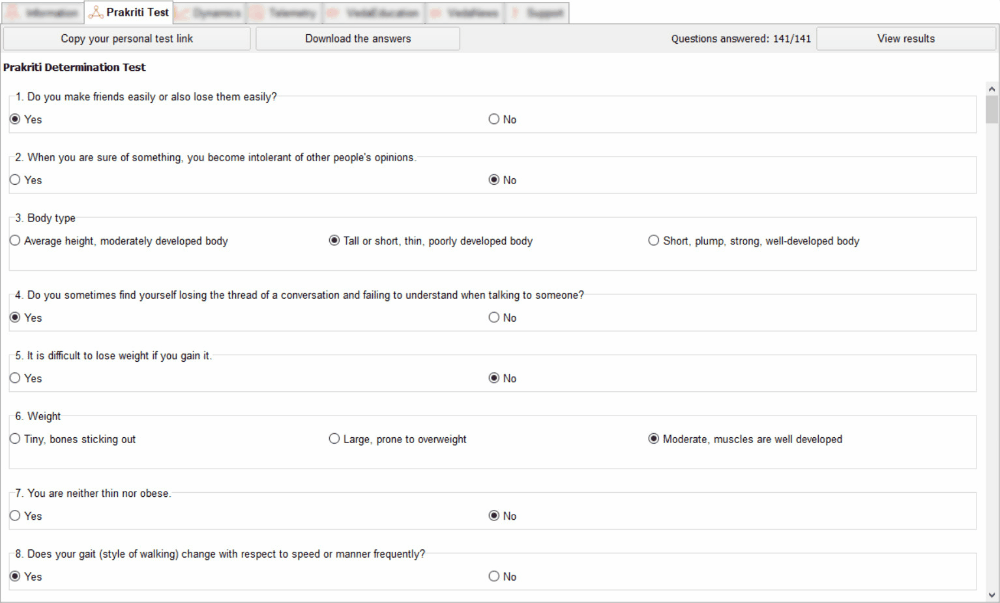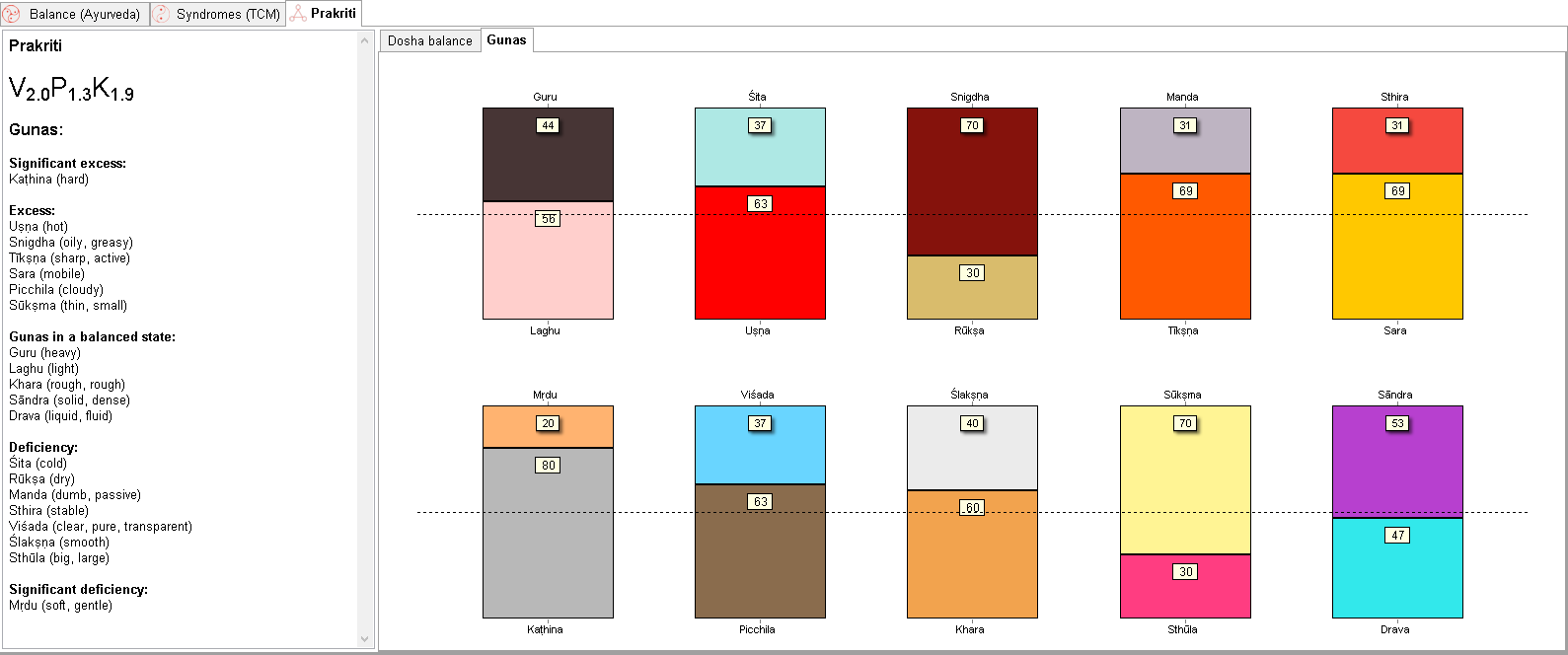Constitution is the main diagnostic module in the VedaPulse Professional program. It is designed to analyze the constitution and syndromes from the perspective of Ayurvedic and Chinese medicine, to assess the ratio of Sattva-Rajas-Tamas Gunas and Prana-Tejas-Ojas trends, as well as to analyze the ratio of 10 pairs of Gunas (material qualities). Watch a video presentation of the module's capabilities from the author and chief developer of the VedaPulse technology, Dr. O. Sorokin.
Module contains 3 tabs: Balance (Ayurveda), Syndromes (TCM), Prakriti.
Balance is one of the most important indicators, which is calculated by the VedaPulse Professional software. This chart reflects the balance of 3 doshas: Vata, Pitta and Kapha from the position of Ayurveda, taking into account their physiological equivalents.
For those who are not familiar with the Ayurveda, Dosha can be represented as their physiological equivalents:
The physiological equivalents of Vata Dosha — central nervous regulation, central and segmental sympathetic regulation, ergotrophic zones of the hypothalamus.
The physiological equivalents of Pitta Dosha — systemic endocrine regulation of metabolism mainly by hormones of the catabolic spectrum (pituitary and effector glands), the level of metabolism and thermoregulation, hormones of catabolic action (adrenaline).
The physiological equivalents of Kapha Dosha — the immune system, lymphatic system, local tissue endocrine regulation system, anabolic hormones (insulin, growth hormone, steroids), parasympathetic nervous system, biological secretions production systems (cerebrospinal fluid, lymph, synovia), all mucous membranes.
Ranges:
- 0-1 (yellow) — cachexia (kshaya), high chance of physiological disorders
- 1-2 (light green) — tendency to exhaustion, possible functional disorders
- 2-4 (green) — normal (when all 3 doshas are within this range, it is tridosha state)
- 4-5 (light green) — tendency to aggravation, biochemical and psychosomatic stage of disease development;
- 5-7 (pale red) — aggravation, functional and clinical stage of disease development, imbalance state, high chance of physiological disorders
- 7-8,5 (red) — strong aggravation, in which crisis manifestations and a violation of the structure of organs and systems are possible
This tab also contains information about the characteristics of the pulse: Vega (rate), Tala (rhythm), Bala (strength), Tapamana – temperature of pulse (strength of the digestive fire, Agni), which reflect the signs of Prakriti in the pulse.
Gunas sub tab reflects the state of the 3 Mental Gunas – Sattva, Rajas, Tamas – and their connection with Doshas.
Sattvic type – Sattvic type is less susceptible to diseases than others, nature is harmonious and easily adaptable. Strives for balance and peace of mind, thereby depriving the disease of mental causes. People of this type are attentive to others and take care of themselves. They take life as a necessary experience and try to benefit from everything, including illness.
Rajasic type – Rajasic type are usually endowed with great energy, but they can "burn" themselves with excessive activity. Their symptoms of the disease are usually acute, recovery is possible if the correct therapeutic measures are applied. They are impatient and inconsistent in the treatment of the disease and do not want to waste time for the sake of their recovery or take responsibility for it. They prefer to blame others for their illnesses.
Tamasic type – Tamasic type is mostly prone to prolonged, chronic diseases, including immunopathological ones. Their energy and emotions tend to stagnate. Generally, diseases become deeply rooted, torpid and difficult to treat. People of this type do not seek to get the necessary treatment; they leave everything to chance. Their hygiene is usually at a low level. They perceive their illness as fate and do not use any methods that could help them.
In the example on the right, you can see that the patient has the dominance of Tamas guna and the manifestation of Kapha in Tamas.
Prana-Tejas-Ojas are three important energies/substances/quintessences that determine energy balance, state of the endocrine system and immunity:
- Prana indicates energy levels.
- Tejas reflects the state of the endocrine system.
- Ojas reflects the state of immunity.
The program evaluates trends (decrease, normal, increase) and determines which of them is characteristic of the patient's Prana, Tejas and Ojas at a given time.
The graph shows the balance of 3 elements from the perspective of Chinese medicine: Wind, Heat and Dampness. The tab contains a fully automated description of 9 TCM syndromes (constitutional features, manifestations, psychological characteristics, adaptability) with a list of diseases for each of the Syndromes:
Excess of Dampness Syndrome — the predisposition to diabetes mellitus, early cognitive dysfunction, angina pectoris, hyperproliferative processes, etc.
Blood stagnation Syndrome — the hemostasis system misfunctioning (increased clotting, thick blood), gynecological diseases (with a tendency to fibromyomas), IBS syndrome with functional pain, bloating, stagnation in the lungs, chest congestion, shortness of breath, chest and heart pain, etc.
Qi Stagnation Syndrome — depression, dryness of the Tsang organs, insomnia, functional diseases of the nervous system, a feeling of "lump in the throat", fear, etc.
Yang Excess Syndrome (stagnant fever) — hypertension, heart attacks, strokes, acne, damaged body fluids, dysphoria.
Damp Heat Syndrome — furuncles, jaundice (heat and fire syndromes).
Deficiency (emptiness) of Yin Syndrome – manifestations of dry heat with Yin damage, or Yin damage as a result of the disease, early signs of aging and withering of the skin, a tendency to hormonal diseases, dehydration.
Deficiency (emptiness) of Qi Syndrome — general debility and weakness of the protective forces provoke frequent colds, a tendency to visceroptosis (internal organs prolapse), general exhaustion, etc.
Deficiency (emptiness) of Yang Syndrome — shivering, cooling of limbs, diarrhea, slow pulse, as well as a tendency to hyperproliferative processes, impotence, etc.
Blood deficiency (emptiness) Syndrome — empty heat with further Yin and blood damage, atopic and dystrophic dry dermatitis, blood damage as a result of physical and mental overload.
How to identify Prakriti using VedaPulse? Find the "Test" tab in the top horizontal menu and answer the 141 test questions. You can view the test results in the Constitution module under the Prakriti tab, which contains 2 sections - Doshas and Gunas.
The Doshas section presents a bar chart of the human constitution. The diagram is divided into 4 areas, coloured yellow, green and pink, according to the degree of predominance of one or another dosha (yellow - Dosha kshaya, Dosha is decreased, pink - a tendence to the Dosha excitement, dark pink - Dosha is excited).
In the text field you can read the report about the constitution formula (on a scale from 0 to 3.5 cu. in accordance with the concept of the guru of pulse diagnosis Dr. Vasant Lad).
The Gunas section presents 10 pairs of Gunas - qualities of the material nature - with an indication of the proportion of each Gunas. Today VedaPulse is the only system in the world capable of assessing the Guna balance. When you hover over the area of a particular Guna, you will see a tooltip with the name of Guna, its quality, the value of the fraction and the main action. Knowing the Guna balance is necessary for expert work with a patient, and allows you to choose the therapy more accurately. For example, to prescribe herbs based on the principles of Dravya Guna, taking into account the patient's Guna balance.
In the text field you can read the report about Gunas in the order of their predominance (excess), balance and deficiency.
Who will benefit from using this module?
Constitution is helpful for every practitioner, who use methods of traditional (holistic) medicine in their practice:
